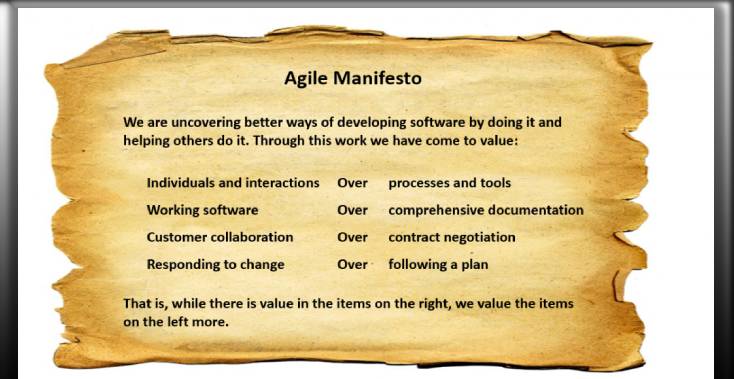Table of Contents
Introduction
The Agile Manifesto draws on Agile software development’s central values & principles. Authoritatively referred to as the Manifesto for Agile Software Development, the guide intends to provide an effective model for teams to successfully embrace the philosophy of Agile project management & utilize it to improve their work process.
Whereas the creative document aims to help software developers build business solutions rapidly and efficiently, it has dramatically affected the broader development industry and beyond.
History of the Agile Manifesto:
In February 2001, seventeen software development specialists gathered at a ski resort in Utah. Indeed, they were there to ski, relax, eat & drink. Nonetheless, most importantly, they were there to wail, to be officious, and to solve problems.
For clarity, the manifesto was written as an answer to significant frustration with the traditional development processes of the 1990s. Notwithstanding having widely varying opinions on how to approach software development, the group settled on at least one thing: the status quo was not working.
The group then named themselves “The Agile Alliance.” Out of their congregation in Utah came The Agile Manifesto, a transitory document built on four values & 12 principles for Agile software development.
Creators of Agile Manifesto:
As identified above, software practitioners from different backgrounds gathered to form the Agile Alliance, creating The Agile Manifesto. Below are the ones who signed the Agile Manifesto back in 2001:
- Kent Beck: Co-creator of eXtreme Programming (XP).
- Mike Beedle is the co-author of Agile Software Development (Scrum).
- Arie van Bennekum: Proprietor of Integrated Agile.
- Alistair Cockburn: IT strategist & creator of the Crystal Agile Methodology.
- Ward Cunningham is the inventor of wiki and technical debt.
- Martin Fowler: Software partner & practitioner (Thoughtworks).
- James Grenning: Writer of TDD.
- Jim Highsmith: Maker of Adaptive Software Development (ASD).
- Andrew Hunt: Co-author of The Pragmatic Programmer.
- Ron Jeffries: Co-creator (eXtreme Programming) (XP).
- Jon Kern: Supporter & Collaborator.
- Brian Marick: A computer scientist & author of programming books.
- Robert C. Martin: AKA “Uncle Bob,” Clean Coding Consultant.
- Steve Mellor is a computer scientist who invented object-oriented system analysis (OOSA).
- Ken Schwaber: Co-created Scrum with Jeff Sutherland.
- Jeff Sutherland: Inventor & co-creator of Scrum.
- Dave Thomas: Programmer & Co-author of The Pragmatic Programmer.
What are the 4 Agile Values?
The Agile Manifesto was established on four fundamental values, which are as follows:
- Individuals and interactions over processes and tools.
- Working software over comprehensive documentation.
- Customer collaboration above contract negotiation.
- Responding to change over following a plan.
Additionally, these four values systemize the basis of Agile software development, weighing priority areas for teams to focus their dynamisms on.
What are the 12 Manifesto Principles?
The Agile Manifesto states 12 principles for software developers:
- The highest priority is to please the customer through early & continuous delivery of valuable software.
- Welcome varying requirements, even late in development.
- Deliver working software frequently, with a liking for the shorter timescale.
- Togetherness between clients & developers.
- Build projects around motivated individuals.
- Face-to-face conversations.
- The prime measure of progress must be working on the software.
- Agile processes promote sustainable development.
- Incessant attention to technical excellence and good design enhances agility.
- Self-organizing teams.
- Teams must reflect on becoming more effective.
Conclusion:
In conclusion, the Agile Manifesto has transformed software development and project management. Its ideologies prioritize individuals & interactions, working solutions, and customer collaboration over firm processes and documentation.
By nurturing adaptability, continuous improvement, and customer-centricity, Agile methodologies have facilitated teams to respond rapidly to changing requirements and deliver value faster. This approach has become a basis in software development and various industries seeking more efficient & customer-focused practices.
As organizations continue to embrace Agile, it’s evident that its influence will persist, driving innovation, enhancing collaboration, and ultimately leading to more successful and customer-satisfying outcomes in the ever-evolving business landscape.

